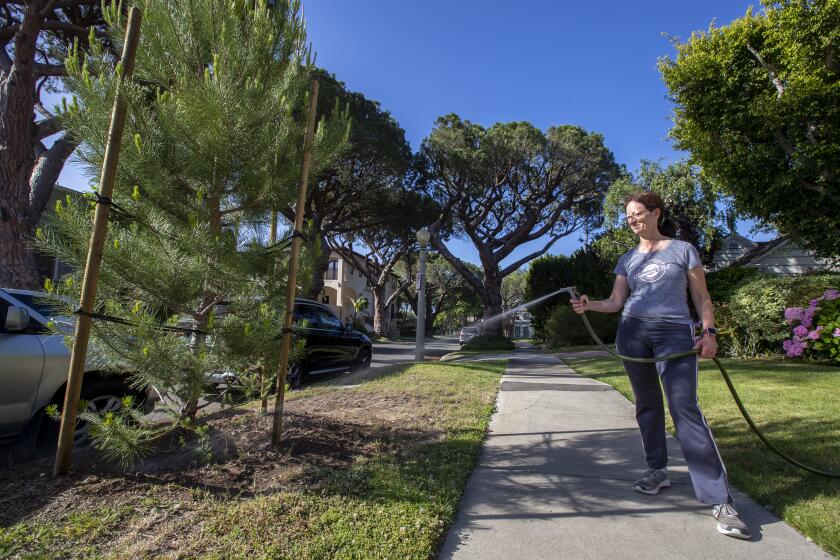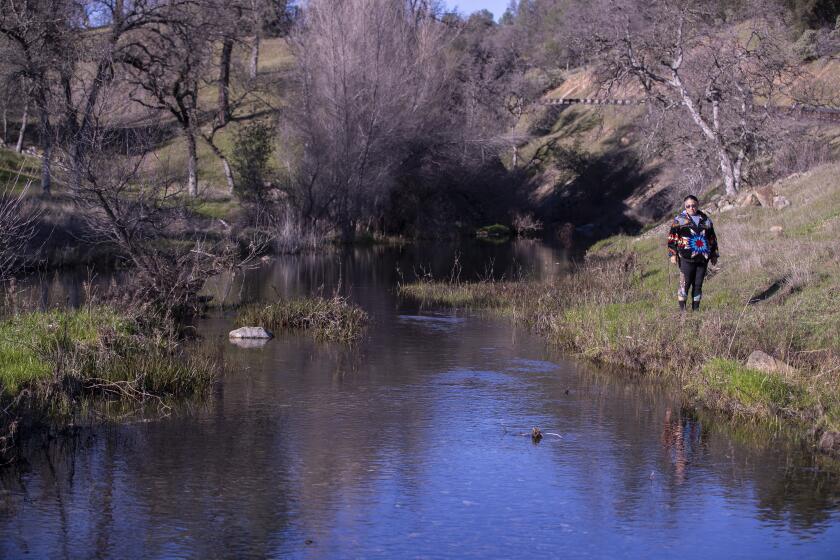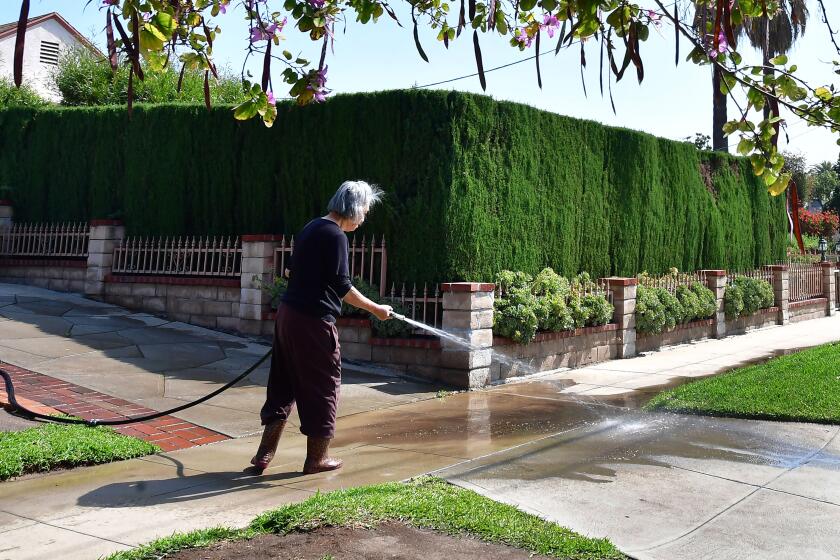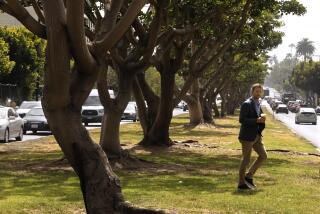SoCal’s lush golf courses face new water restrictions. How brown will the grass go?
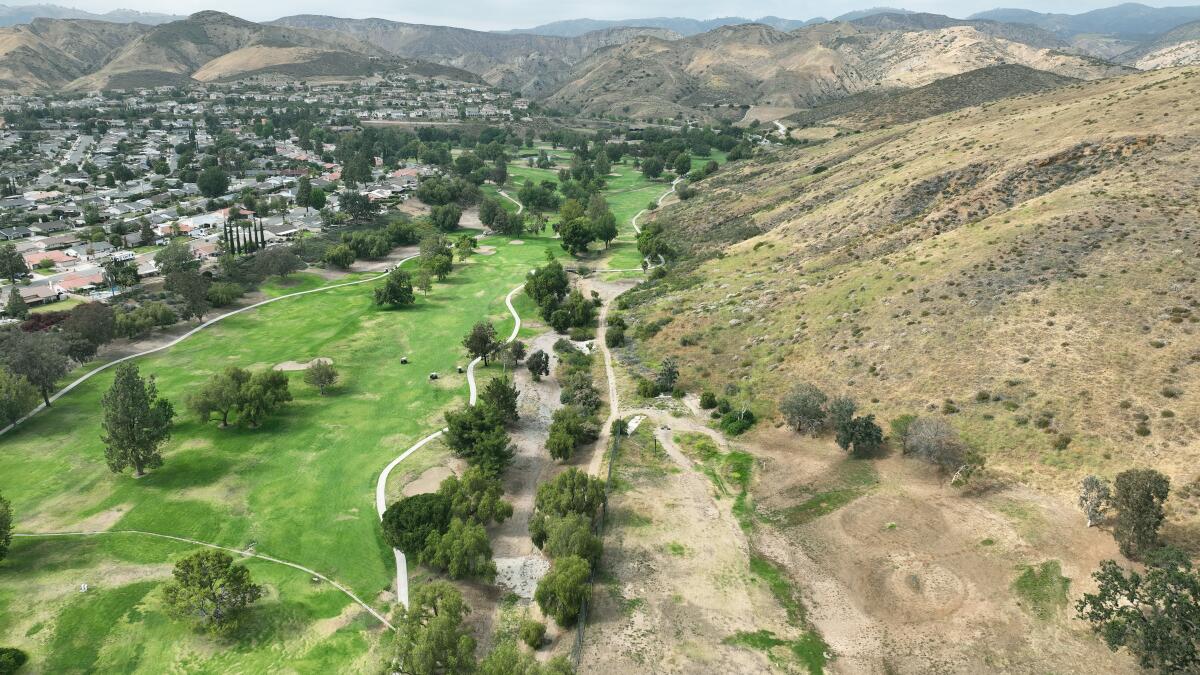
- Share via
To some residents of Southern California, the golf course is a detested symbol of social privilege and water profligacy — a lush playground for the wealthy that can drink more than 100 million gallons a year, even as neighboring lawns shrivel and brown.
“Why are golf courses still a thing?” East Hollywood resident Spence Nicholson said recently. The 38-year-old called them little more than a “massive waste” of resources.
Although the golf industry has long weathered the resentment of nongolfers, owners and managers of links are finding themselves targeted by state water officials who say California is not doing enough to conserve water in a time of severe drought.
Now, golf courses are being told to reduce water use under new drought restrictions in parts of Southern California, and managers of courses say they’re preparing to dial back their sprinklers and let some green grassy areas turn brown.
The water restrictions include a range of different requirements across Southern California, and the rules for courses vary depending on the city or district that delivers water. In some cities, those who run golf courses say they’re waiting for additional details from local agencies to determine exactly how much they will need to cut back.
The strictest water-saving rules apply to dozens of courses in cities from Simi Valley to Los Angeles, where the Metropolitan Water District of Southern California has ordered restrictions on outdoor watering to conserve scarce supplies from the State Water Project.
The Sites Reservoir plan would flood a bucolic valley north of Sacramento. Environmentalists say it would do little to solve California’s water woes.
“We’ll make the necessary adjustments,” said Phil Lopez, general manager of El Caballero Country Club in Tarzana. “It’ll look a little different in some spots. But that’s the world we live in here. And we’re all willing to do our part.”
The 600-member country club, which gets water from the Los Angeles Department of Water and Power, has already found ways to conserve water, Lopez zaid.
Last year, the 18-hole course shut down for nine months to undergo a major refurbishing. Workers replaced decades-old grass with drought-tolerant hybrid Bermuda grass.
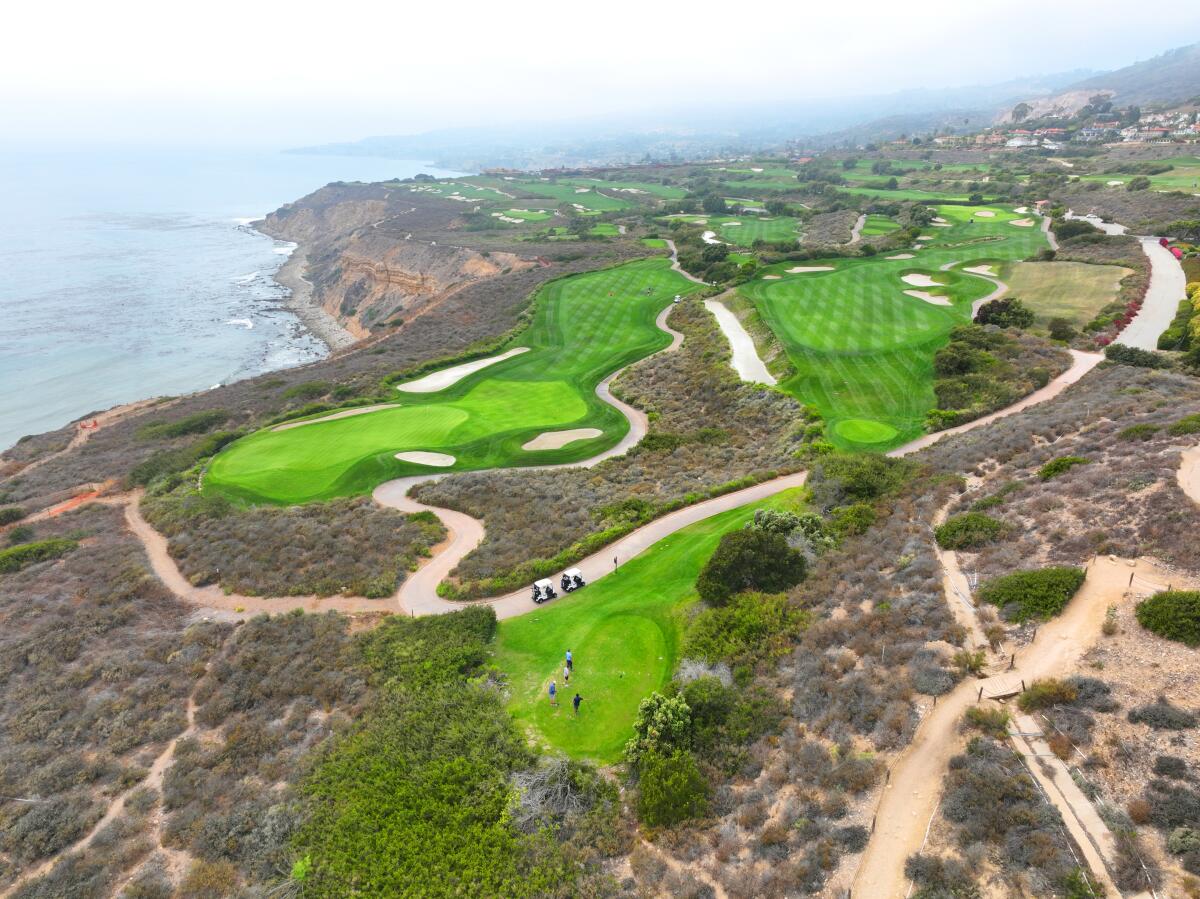
Those 92 acres of low-water-use grass, along with the conversion of some grass to areas landscaped with native plants, have helped the course reduce water usage by between 20% and 25%, Lopez said.
“We can’t just rely on the same amount of water we’ve always had because that’s not going to be plausible in the future,” Lopez said.
Lopez said that given the current shortage, the course is prepared to further reduce its water use.
Historic water restrictions took effect as residents braced for a long brown summer of drought.
But as residents cope with their own restrictions, some say the water that is dedicated to golf should be scaled back much more.
“They ask the public to reduce watering our lawns, when if you look at the numbers of all the lawns in California, the water usage is a blip in comparison to golf courses, other recreational venues for the affluent and corporate properties,” Nicholson said.

Subscribers get exclusive access to this story
We’re offering L.A. Times subscribers special access to our best journalism. Thank you for your support.
Explore more Subscriber Exclusive content.
Although some nongolfers view the area’s courses as exclusive enclaves, not all are private country clubs with wealthy members. Some of Southern California’s heavily used courses are public facilities frequented by people of various income levels, where the green fees for playing 18 holes can range from about $30 on weekdays to about $50 on weekends.
The new restrictions in L.A. limit customers to watering two days a week — odd-numbered address on Monday and Friday, and even addresses on Thursday and Sunday.
The city’s emergency conservation ordinance allows for large landscape areas, including golf courses, parks and sports fields, to deviate from the two-day-a-week rule by requesting an “alternative means of compliance,” which requires reducing monthly water usage by the amount called for under the shortage, plus an additional 5% reduction below a base line of historical water usage.
Tribes and environmentalists are demanding California revise a key water plan, saying the Delta’s ecological crisis is tied to the history of racism.
For golf courses, that means the requirements will vary.
“We have to look on a case-by-case basis,” said Delon Kwan, the DWP’s assistant director of water resources. “Some of them have reduced water usage over the last several years. So it’s not an across-the-board target that they have to achieve.”
Kwan said the department’s staff will consider historical water usage, including in the base-line year of 2009, as well as how much a course has reduced water use in recent years.
“We have to look at it to see where they’re at and how much they’ve reduced,” Kwan said.
The restrictions apply to golf courses that use potable water but not golf courses that rely on recycled wastewater.
There are 37 golf courses in the DWP’s territory, according to the department, including full-size courses as well as some smaller courses with just three or four holes. Twenty golf courses are private, and 17 are public municipal courses.
Recycled water is used to irrigate 11 of these golf courses, eight of them municipal courses.
In all, the L.A.-area golf courses annually use about 3,000 acre-feet (977 million gallons) of recycled water and about 5,000 acre-feet (1.6 billion gallons) of drinking water, according to the DWP. The golf courses on average account for about 1% of the city’s total use of potable water.
Anne Huston, who lives in L.A., said she thinks it’s time to get rid of golf courses because “they waste space and water.”
“There’s all these incentives to replace your lawn with drought-tolerant alternatives … but my entire neighborhood of teeny, tiny lawns doesn’t even come close to a small fraction of, say, the golf course at Wilshire Country Club not far from me,” said Huston, 38. “Literally 100 acres of land. What are they doing to replace their lawn for drought tolerance?”
Huston said she feels so strongly about the issue that she recently signed a petition calling for the elimination of golf courses in California.
“It feels obvious to me that in this climate crisis we don’t have the luxury of wasted space and heavy water consuming green grass for only the rich to walk on,” she said.
Large portions of Southern California are being told to water outdoors just one day a week. And a total watering ban could be imposed by fall.
The last three years have been some of the driest on record in California, and scientific research shows global warming has been intensifying the extreme aridity throughout the West over the last 22 years.
The MWD ordered water restrictions starting June 1 across a large portion of its territory, including parts of Los Angeles, Ventura and San Bernardino counties that are dependent on the drought-ravaged State Water Project. The district’s managers have said they could shift to a total ban on outdoor watering as soon as September if conservation efforts don’t achieve needed targets.
Other water agencies that fall under the new restrictions include the Inland Empire Utilities Agency, Las Virgenes Municipal Water District, Calleguas Municipal Water District, Three Valleys Municipal Water District and Upper San Gabriel Valley Municipal Water District. These districts in turn provide water to cities and smaller suppliers.
How different cities and water suppliers treat golf courses depends on the local rules.
In Chino Hills, for example, there are two golf courses. One course, Los Serranos Golf Club, relies entirely on recycled water and isn’t subject to the restrictions. The other, Western Hills Golf & Country Club, uses a mix of imported water and other supplies and falls under the restrictions, said Nicole Freeman, a spokesperson for the city.
The “Stage 3” restrictions in Chino Hills limit residents and businesses to watering two days per week. Alternatively, businesses may be exempt from the twice-a-week watering rule if they reduce their potable water usage by 28% compared with 2013, Freeman said.
The rules are different in the area served by Las Virgenes Municipal Water District, which supplies Agoura Hills, Calabasas, Hidden Hills, Westlake Village and unincorporated areas of western L.A. County.
The two golf courses in the area use recycled water and some groundwater, and since December they’ve been required to reduce water use 25% below their individualized water budgets, said Michael McNutt, a spokesperson for the district.
While some water agencies are urging the use of pool covers, most stop short of prohibiting the filling of swimming pools.
In Simi Valley, water is delivered by Calleguas Municipal Water District, which is requiring one-day-a-week watering restrictions.
Exactly how much the public Simi Hills Golf Course will need to reduce watering will be determined as managers of the Rancho Simi Recreation and Park District decide how to allocate the cuts among the local parks, said Brian Reed, the golf course manager.
Reed said he expects to need to reduce watering around the edges of the course, “heavier cuts to the out-of-play areas,” while keeping up watering for the most important playing areas: the greens, tees and fairways.
Simi Hills has about 100 acres of grass and five ponds. Reed said the course’s current water use is about 110 million gallons a year, an amount that has already come down with conservation improvements over the years.
“It’s a very big expense for us every year. So we actively manage our water use,” Reed said. That includes using an irrigation system that enables the staff to closely monitor and adjust watering.
He said he may instruct his staff to reduce the run time on parts of the irrigation system, while shutting off some sprinklers.
If the course has to reduce watering in the rough, Reed said, the grass in those areas will lose its green.
“It’ll go a little brown,” Reed said. “It just is what it is. I mean, there just won’t be as much green lush grass in the areas around the edges of the golf course.”
In one wealthy Los Angeles County enclave, 70% of water is used outdoors. Officials hope to curb chronic overuse with these custom flow restrictors.
While managers of courses adjust to the new local rules, they may also be asked to start differentiating between playable areas and other surrounding non-playable areas.
The State Water Resources Control Board last month adopted regulations that outlaw the use of drinking water for irrigating “nonfunctional” grass at commercial, industrial and institutional properties.
Sports fields are exempt, as are parts of golf courses that are used for the game, such as the greens and fairways. But the state board’s staff has said water agencies and golf courses should evaluate whether other turf on a golf course property is “functional” or not.
The rules should apply to golf courses in the same way that restrictions apply to everyone else, said Charming Evelyn, chair of the water committee for the Sierra Club’s Angeles Chapter. Evelyn, who has advocated for more use of recycled water for golf courses, said she hopes to see golf courses make more progress reducing water use, including by switching to more drought-tolerant grasses.
“Residents can reduce water use outdoors. And a lot of them have done so. But we also have to be looking at businesses, and golf courses,” Evelyn said. “They really need to have businesses reduce quite a bit.”
Craig Kessler, director of public affairs for the Southern California Golf Assn., said that golf courses have made major strides in using less water over the last two decades by investing in efficient irrigation systems, switching to other types of grasses, and replacing some turf with low-water-use landscaping.
He said managers of golf courses recognize that they will need to “go further and even faster” to adapt to these drier times.
More to Read
Go beyond the scoreboard
Get the latest on L.A.'s teams in the daily Sports Report newsletter.
You may occasionally receive promotional content from the Los Angeles Times.

